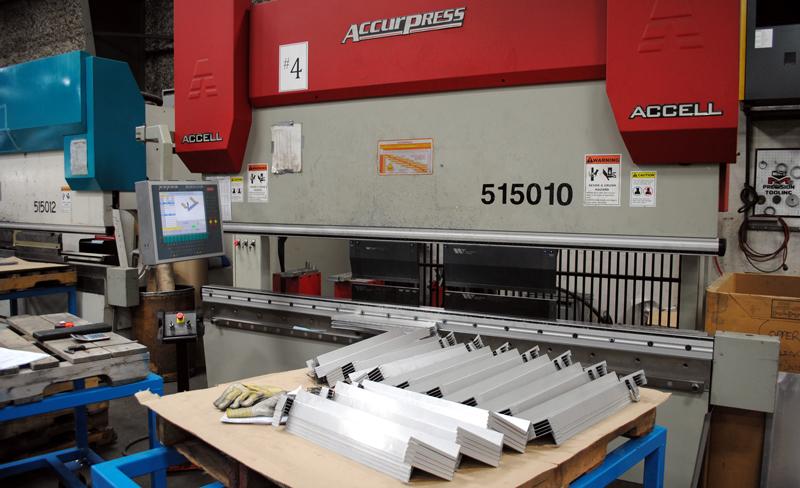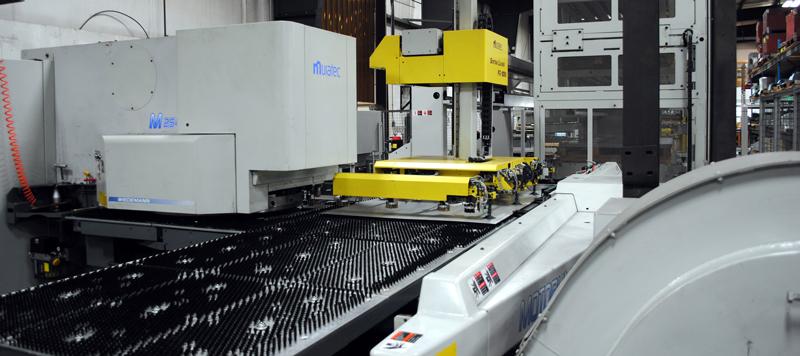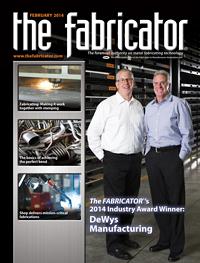- FMA
- The Fabricator
- FABTECH
- Canadian Metalworking
Categories
- Additive Manufacturing
- Aluminum Welding
- Arc Welding
- Assembly and Joining
- Automation and Robotics
- Bending and Forming
- Consumables
- Cutting and Weld Prep
- Electric Vehicles
- En Español
- Finishing
- Hydroforming
- Laser Cutting
- Laser Welding
- Machining
- Manufacturing Software
- Materials Handling
- Metals/Materials
- Oxyfuel Cutting
- Plasma Cutting
- Power Tools
- Punching and Other Holemaking
- Roll Forming
- Safety
- Sawing
- Shearing
- Shop Management
- Testing and Measuring
- Tube and Pipe Fabrication
- Tube and Pipe Production
- Waterjet Cutting
Industry Directory
Webcasts
Podcasts
FAB 40
Advertise
Subscribe
Account Login
Search
Automation relieves punching bottleneck
- By Sue Roberts
- February 28, 2014
- Article
- Punching and Other Holemaking
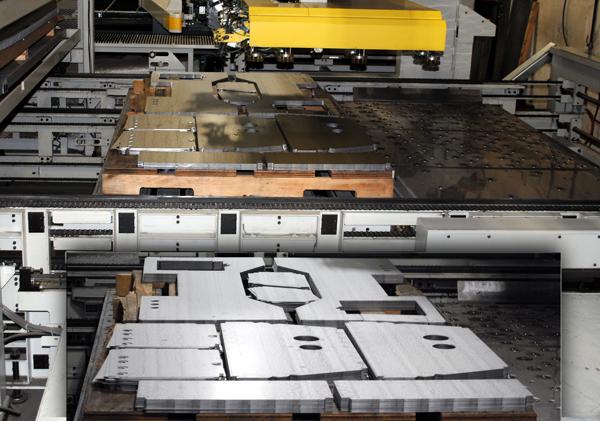
Figure 1
SigmaNEST software directs stacking of parts finished on
the Motorum M2548. Parts are ready to move on to the
next process.
The shop at Overlanders Manufacturing will gain elbow room and new capabilities by the end of 2014. A 30,000-sq.-ft. expansion will nearly double the size of the current 38,000-sq.-ft. Abbotsford, B.C., Canada’s plant. The extra room will house a powder coating line and other finishing equipment, two lines for product assembly and packaging, and perhaps make it possible for the company to consider automation options that come with footprints that just don’t fit in the current floor plan.
Space limitations, though, didn’t prevent the job shop from taking steps to speed up the production of custom sheet metal parts, tubular products, and precision components and stepping up lights-out production by adding automation to its punching process.
Three turrets had been producing parts that needed to be shaken free from full sheets and run through a deburring process before the addition of the automated cell. “Sheet metal parts were tabbed into a 4- by 8-ft. sheet, and there would be one or two employees taking parts out,” said George Moore, engineering/IT manager at Overlanders. “I thought it would be best to utilize those people for something more important (see Figure 1).”
Call to Action
Reducing labor while maintaining or improving throughput within available space became the challenge.
“We looked at the purchase of the automated cell for about three years before moving forward,” said Moore. Although he was impressed with the system made up of a Muratec Motorum M2548 turret, FG-1250 sorting loader, and eight-drawer tower from the beginning, some people had concerns regarding the slight delay in punching while the robotic vacuum cup arm is positioned and lowered to remove each punched piece. Depending on the part configuration and placement on the sheet, removal can take from 8 to 12 seconds.
But labor advantages tipped the scale in favor of the purchase. “If the process takes a few seconds longer to complete a run, it doesn’t matter because it is producing parts by itself. Nobody is there watching it,” Moore said.
With limited space in the plant, the company was unable to install a machine and automation with a 5- by 10-ft. sheet capacity, so it ended up with a configuration that has a 4- by 8-ft. sheet automated capacity that fits in a very compact footprint. The M2548 punch press can be run without the automation, which offers versatility for jobs up to 10 ft. long.
All for One
Once the new punch press was in place, the shop directed work from two older punch presses that were manually loaded and unloaded and a Motorum M2048 with load/unload automation to the new system. It’s made a big difference (see Figure 2).
“We were able to take almost all the work from three existing turrets and move it to the new machine,” said Moore. “We saved a lot of manual labor that is not nice to do, like taking parts out of skeletons and deburring.
“One operator working 40 hours a week can set up and maintain the machine, handle loading and unloading the tower, and take care of the tools using about half his time. Then he does other jobs. We run two shifts and don’t have an operator on the second shift because the punch runs itself. We get about 125 hours of uptime out of that cell each week.”
The vacuum cup sorting feature also fit well with the material mix—typically thin gauge with a healthy percentage of aluminum—used to produce parts for the agriculture, mining, forestry, and fireplace manufacturing industries. Small vacuum cups nested within larger cups at the end of the robotic arm grab and safely remove large components or formed parts such as tread plates with countersink features.
“The majority of the punching for a part is done first, with a small connection to the sheet left intact,” Moore said. “That allows us to pull the part into the open, out of the turret, while it is attached to the skeleton. One last hit from the subhead punch located on the side of the machine frees the part so it can be picked up and stacked on a pallet or put on one of two carts.”
Big on lights-out operations (see Figure 3), Overlanders tested the system shortly after installation. “We tried to see how much we could do when we pressed the go button and left it over the weekend. We programmed several jobs that had similar material and the same turret tooling setup, pushed the button on Friday, and it produced parts through Sunday morning. There were just over 2,800 parts stacked, stored in the tower, and ready to go when we arrived on Monday. We distributed them to six press brakes and just got going.”
Tricks for Even More Production
Even with the built-in efficiencies of the automated system, Moore has some tricks of the trade (see Figure 4) that increase productivity even more. One is to carefully choose the parts that go on the machine.
“We tailor the product that goes on the machine to reduce setups and keep the machine punching. If a company is running six different thicknesses of metal on a machine in one day, they are not going to get the same number of productive hours because they are going to have to change tools more often. We standardize the material thicknesses.
“The majority of our parts are a good size, maybe 5 to 10 maximum out of a sheet. We do have some jobs that call for small parts, but we keep them off this machine. We’ve found that having another turret designated for small parts, even though we could run them on the automated system and have them drop down the chute, is more efficient.”
If the parts are going directly to another process, the sorting system stacks the parts on a table that is rolled over to the next process rather than putting them on a pallet to be stored in the tower or moved with a forklift. “If the parts are going to another process the same day, we just grab the table and roll it over to the next operation,” said Moore.
“Having the machine punch completed parts without tabs is a big savings. The parts come out with clean edges, but if you need to, you can go even further and run a deburring wheel around the parts while they are still in the machine to eliminate the extra process.”
For running production lights-out, Moore doesn’t always push the speed limit of the cell. “When [the press is] running unattended, you want to avoid the risk of a part getting caught and shutting the machine down. So we program the machine to unload at a pace that keeps it running as smoothly as possible.”
In case of a problem or simply during a long weekend when material needs to be restocked, a dialer alerts an off-site employee when attention is needed. “It dials our operator’s phone and lets him know that he needs to unload parts and load material. He will spend an hour at the shop, press the go button, and go back home while the machine resumes processing parts for up to 48 hours without any other operator involvement.”
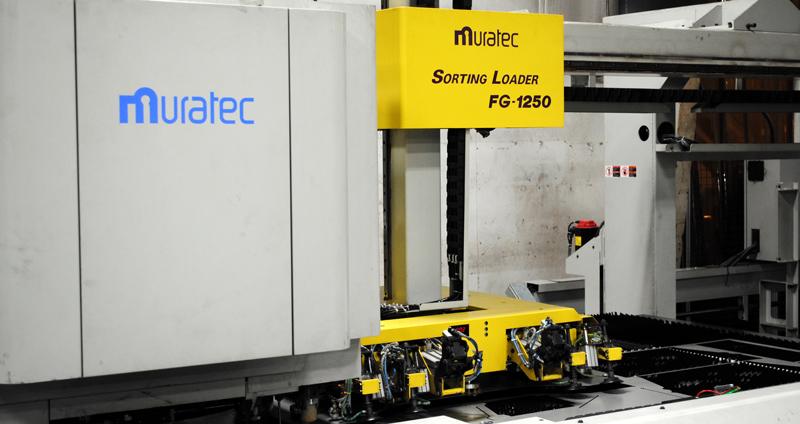
Figure 3
The Muratec FG-1250 removes a part that was punched on a Motorum M2548. The combination of the turret punch press, sorting loader, and eight-drawer tower creates a fully automated cell for lights-out production.
A few months after having the automated system up and running, Overlanders removed one of the old turrets to make room for a new press brake. “We went from being behind on our punching jobs to having extra capacity.
“This system keeps a lot of press brakes busy. If I could put robotic press brakes in here I would be happy. But we don’t have enough plant space, yet.”
About the Author

Related Companies
subscribe now

The Fabricator is North America's leading magazine for the metal forming and fabricating industry. The magazine delivers the news, technical articles, and case histories that enable fabricators to do their jobs more efficiently. The Fabricator has served the industry since 1970.
start your free subscription- Stay connected from anywhere

Easily access valuable industry resources now with full access to the digital edition of The Fabricator.

Easily access valuable industry resources now with full access to the digital edition of The Welder.

Easily access valuable industry resources now with full access to the digital edition of The Tube and Pipe Journal.
- Podcasting
- Podcast:
- The Fabricator Podcast
- Published:
- 04/16/2024
- Running Time:
- 63:29
In this episode of The Fabricator Podcast, Caleb Chamberlain, co-founder and CEO of OSH Cut, discusses his company’s...
- Industry Events
16th Annual Safety Conference
- April 30 - May 1, 2024
- Elgin,
Pipe and Tube Conference
- May 21 - 22, 2024
- Omaha, NE
World-Class Roll Forming Workshop
- June 5 - 6, 2024
- Louisville, KY
Advanced Laser Application Workshop
- June 25 - 27, 2024
- Novi, MI
























